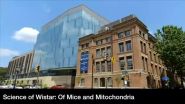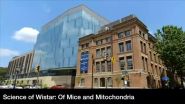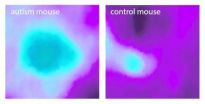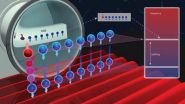(Press-News.org) VIDEO:
TRAP-1 is a protein vital for the production of chemical energy in the mitochondria of cells, but it is over-produced in tumor cells. The laboratory of Dr. Dario Altieri at...
Click here for more information.
While developing a new cancer drug, researchers at The Wistar Institute discovered that mice lacking a specific protein live longer lives with fewer age-related illnesses. The mice, which lack the TRAP-1 protein, demonstrated less age related tissue degeneration, obesity, and spontaneous tumor formation when compared to normal mice. Their findings could change how scientists view the metabolic networks within cells.
In healthy cells, TRAP-1 is an important regulator of metabolism and has been shown to regulate energy production in mitochondria, organelles that generate chemically useful energy for the cell. In the mitochondria of cancer cells, TRAP-1 is universally overproduced.
The Wistar team's report, which appears in the journal Cell Reports (available online now), shows how "knockout" mice bred to lack the TRAP-1 protein compensate for this loss by switching to alternative cellular mechanisms for making energy.
"We see this astounding change in TRAP-1 knockout mice, where they show fewer signs of aging and are less likely to develop cancers," said Dario C. Altieri. M.D., Robert and Penny Fox Distinguished Professor and director of The Wistar Institute's National Cancer Institute-designated Cancer Center. "Our findings provide an unexpected explanation for how TRAP-1 and related proteins regulate metabolism within our cells."
"We usually link the reprogramming of metabolic pathways with human diseases, such as cancer," Altieri said. "What we didn't expect to see were healthier mice with fewer tumors."
Altieri and his colleagues created the TRAP-1 knockout mice as part of their ongoing investigation into their novel drug, Gamitrinib, which targets the protein in the mitochondria of tumor cells. TRAP-1 is a member of the heat shock 90 (HSP90) protein family, which are "chaperone" proteins that guide the physical formation of other proteins and serve a regulatory function within mitochondria. Tumors use HSP90 proteins, like TRAP-1, to help survive therapeutic attack.
"In tumors, the loss of TRAP-1 is devastating, triggering a host of catastrophic defects, including metabolic problems that ultimately result in in death of the tumor cells," Altieri said. "Mice that lack TRAP-1 from the start, however, have three weeks in the womb to compensate for the loss of the protein."
The researchers found that in their knockout mice, the loss of TRAP-1 causes mitochondrial proteins to misfold, which then triggers a compensatory response that causes cells to consume more oxygen and metabolize more sugar. This causes mitochondria in knockout mice to produce deregulated levels of ATP, the chemical used as an energy source to power all the everyday molecular reactions that allow a cell to function.
This increased mitochondrial activity actually creates a moderate boost in oxidative stress ("free radical damage") and the associated DNA damage. While DNA damage may seem counterproductive to longevity and good health, the low level of DNA damage actually reduces cell proliferation—slowing growth down to allow the cell's natural repair mechanisms to take effect.
According to Altieri, their observations provide a mechanistic foundation for the role of chaperone molecules, like HSP90, in the regulation of bioenergetics in mitochondria—how cells produce and use the chemical energy they need to survive and grow. Their results explain some contradictory findings in the scientific literature regarding the regulation of bioenergetics and dramatically show how compensatory mechanisms can arise when these chaperone molecules are taken out of the equation.
"Our findings strengthen the case for targeting HSP90 in tumor cells, but it also opens up a fascinating array of questions that may have implications for metabolism and longevity," Altieri said. "I predict that the TRAP-1 knockout mice will be a valuable tool for answering these questions."
INFORMATION:
This work was supported by grants to Altieri from the National Institutes of Health (P01 CA140043, R01 CA78810) and the Office of the Assistant Secretary of Defense for Health Affairs through the Prostate Cancer Research Program ( W81XWH-13-1-0193). Additional support was provided through the National Cancer Institute Cancer Center Support Grant (CA010815) to The Wistar Institute.
Co-authors from the Altieri lab include Sofia Lisanti, Michele Tavecchio, Ph.D., and Young Chan Chae, Ph.D., Wistar co-authors also include Qin Liu, M.D., Ph.D., an associate professor in Wistar Cancer Center's Molecular and Cellular Oncogenesis program. Co-authors from outside Wistar include Angela K. Brice, D.V.M., Ph.D., from the University of Pennsylvania School of Veterinary Medicine, and Madhukar L. Thakur, Ph.D., and Lucia R. Languino, Ph.D., from Thomas Jefferson University.
'Rewired' mice show signs of longer lives with fewer age-related illnesses
TRAP-1 gene deletion boosts energy production while slowing cell proliferation
2014-07-31
ELSE PRESS RELEASES FROM THIS DATE:
Drug target identified for common childhood blood cancer
2014-07-31
In what is believed to be the largest genetic analysis of what triggers and propels progression of tumor growth in a common childhood blood cancer, researchers at NYU Langone Medical Center report that they have identified a possible new drug target for treating the disease.
T-cell acute lymphoblastic leukemia is one of the most common and aggressive childhood blood cancers. An estimated quarter of the 500 adolescents and young adults diagnosed with the cancer each year in the U.S. fail to achieve remission with standard chemotherapy drugs.
In a cover-story report ...
Molecule enhances copper's lethal punch against microbes
2014-07-31
DURHAM, N.C. – Harnessing a natural process in the body that pumps lethal doses of copper to fungi and bacteria shows promise as a new way to kill infectious microbes, a team of scientists at Duke University report.
Publishing in the July 31, 2014, issue of the journal Chemistry & Biology, the researchers describe a way of exploiting the unique chemical response from the body's immune system to attack pathogens using copper, long known for its antimicrobial properties, in a way that minimizes harm to the rest of the body.
The findings in cell and animal models represent ...
Master HSF supports reprogramming of normal cells to enable tumor growth and metastasi
2014-07-31
CAMBRIDGE, Mass. (July 31, 2014) – Long associated with enabling the proliferation of cancer cells, the ancient cellular survival response regulated by Heat-Shock Factor 1 (HSF1) can also turn neighboring cells in their environment into co-conspirators that support malignant progression and metastasis.
The finding, reported by Whitehead Institute scientists this week in the journal Cell, lends new insights into tumor biology with significant implications for the diagnosis, prognosis, and management of cancer patients.
Over the past several years, researchers in the ...
Insular cortex alterations in mouse models of autism
2014-07-31
This news release is available in German.
The insular cortex is an integral "hub", combining sensory, emotional and cognitive content. Not surprisingly, alterations in insular structure and function have been reported in many psychiatric disorders, such as anxiety disorders, depression, addiction and autism spectrum disorders (ASD). Scientists from Harvard University and the Max-Planck Institute of Neurobiology in Martinsried now describe consistent alterations in integrative processing of the insular cortex across autism mouse models of diverse etiologies. In particular, ...
C. difficile vaccine proves safe, 100 percent effective in animal models
2014-07-31
An experimental vaccine protected 100 percent of animal models against the highly infectious and virulent bacterium, Clostridium difficile, which causes an intestinal disease that kills approximately 30,000 Americans annually. The research is published ahead of print in Infection and Immunity.
In the study, the vaccine protected the mice and non-human primates against the purified toxins produced by C. difficile, as well as from an orogastric spore infection, a laboratory model that mimics the human disease, after only two immunizations.
"Animals that received two ...
Scientists find growing consensus: Political attitudes derive from body and mind
2014-07-31
Lincoln, Neb., July 31, 2014 -- Do people make a rational choice to be liberal or conservative? Do their mothers raise them that way? Is it a matter of genetics?
Two political scientists from the University of Nebraska-Lincoln and a colleague from Rice University say that neither conscious decision-making nor parental upbringing fully explain why some people lean left while others lean right.
A growing body of evidence shows that physiological responses and deep-seated psychology are at the core of political differences, the researchers say in the latest issue of the ...
Strict genomic partitioning by biological clock separates key metabolic functions
2014-07-31
Irvine, Calif., July 31, 2014 — Much of the liver's metabolic function is governed by circadian rhythms – our own body clock – and UC Irvine researchers have now found two independent mechanisms by which this occurs.
The study, published online today in Cell, reveals new information about the body clock's sway over metabolism and points the way to more focused drug treatments for liver disease and such metabolic disorders as obesity and diabetes.
Paolo Sassone-Corsi, UCI's Donald Bren Professor of Biological Chemistry, and postdoctoral scholar Selma Masri report that ...
Simple tips to fend off freak-outs
2014-07-31
There's sad news in the study of happiness.
Rest assured, there is a happy ending, though.
University of Cincinnati research on perceived happiness shows that many college students are stressed out and aren't coping.
This is despite the fact that there are simple ways for students to relieve stress and feel happier, says Keith King, professor and coordinator of UC's Health Promotion and Education Program. The trouble is, they don't use them enough.
"We have a whole array of different stress-management techniques college students can use and that we teach, but they're ...
New report calls for strong, positive safety culture in academic chemical labs
2014-07-31
WASHINGTON -- Everyone involved in the academic chemical research enterprise -- from researchers and principal investigators to university leadership -- has an important role to play in establishing and promoting a strong, positive safety culture, says a new report from the National Research Council. This requires a constant commitment to safety organization-wide and emphasis on identifying and solving problems, rather than merely adhering to a set of rules and assigning blame when those rules are not followed.
Chemical hazards can be found in many academic fields ...
Spin diagnostics
2014-07-31
Magnetic resonance imaging (MRI), which is the medical application of nuclear magnetic resonance spectroscopy, is a powerful diagnostic tool. MRI works by resonantly exciting hydrogen atoms and measuring the relaxation time -- different materials return to equilibrium at different rates; this is how contrast develops (i.e. between soft and hard tissue). By comparing the measurements to a known spectrum of relaxation times, medical professionals can determine whether the imaged tissue is muscle, bone, or even a cancerous growth. At its heart, MRI operates by quantum principles, ...
LAST 30 PRESS RELEASES:
MD Anderson and RUSH unveil RUSH MD Anderson Cancer Center
Tomography-based digital twins of Nd-Fe-b magnets
People with rare longevity mutation may also be protected from cardiovascular disease
Mobile device location data is already used by private companies, so why not for studying human-wildlife interactions, scientists ask
Test reveals mice think like babies
From disorder to order: flocking birds and “spinning” particles
Cardiovascular risk associated with social determinants of health at individual and area levels
Experimental NIH malaria monoclonal antibody protective in Malian children
Energy trades could help resolve Nile conflict
Homelessness a major issue for many patients in the emergency department
Undocumented Latinx patients got COVID-19 vaccine at same rate as US citizens
ETRI develops an automated benchmark for labguage-based task planners
Revolutionizing memory technology: multiferroic nanodots for low-power magnetic storage
Researchers propose groundbreaking framework for future network systems
New favorite—smart electric wheel drive tractor: realizes efficient drive with ingenious structure and intelligent control
Using stem cell-derived heart muscle cells to advance heart regenerative therapy
Damon Runyon Cancer Research Foundation awards Quantitative Biology Fellowships to four cutting-edge scientists
Climb stairs to live longer
Scientists capture X-rays from upward positive lightning
AMS Science Preview: Hawaiian climates; chronic pain; lightning-caused wildfires
Researchers advance detection of gravitational waves to study collisions of neutron stars and black holes
Automated machine learning robot unlocks new potential for genetics research
University of Toronto scientists appointed as GSK chairs will advance drug delivery research and vaccine education tools for healthcare professionals
Air pollution and depression linked with heart disease deaths in middle-aged adults
More efficient molecular motor widens potential applications
Robotic nerve ‘cuffs’ could help treat a range of neurological conditions
Researchers identify targets in the brain to modulate heart rate and treat depressive disorders
Findings of large-scale study on 572 Asian families supports gene-directed management of BRCA1 and BRCA2 gene carriers in Singapore
Many children with symptoms of brain injuries and concussions are missing out on vital checks, national US study finds
Genetic hope in fight against devastating wheat disease
[Press-News.org] 'Rewired' mice show signs of longer lives with fewer age-related illnessesTRAP-1 gene deletion boosts energy production while slowing cell proliferation





